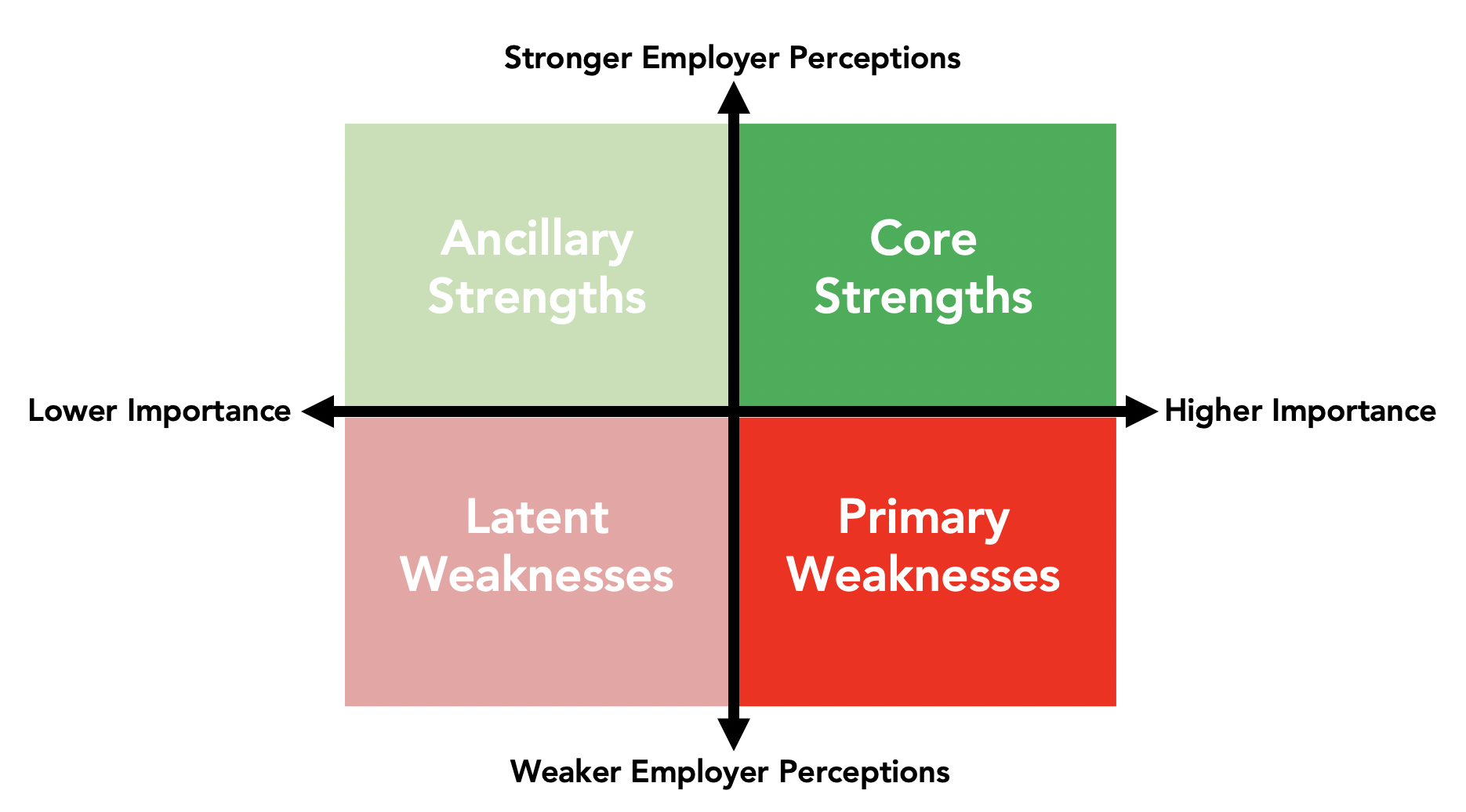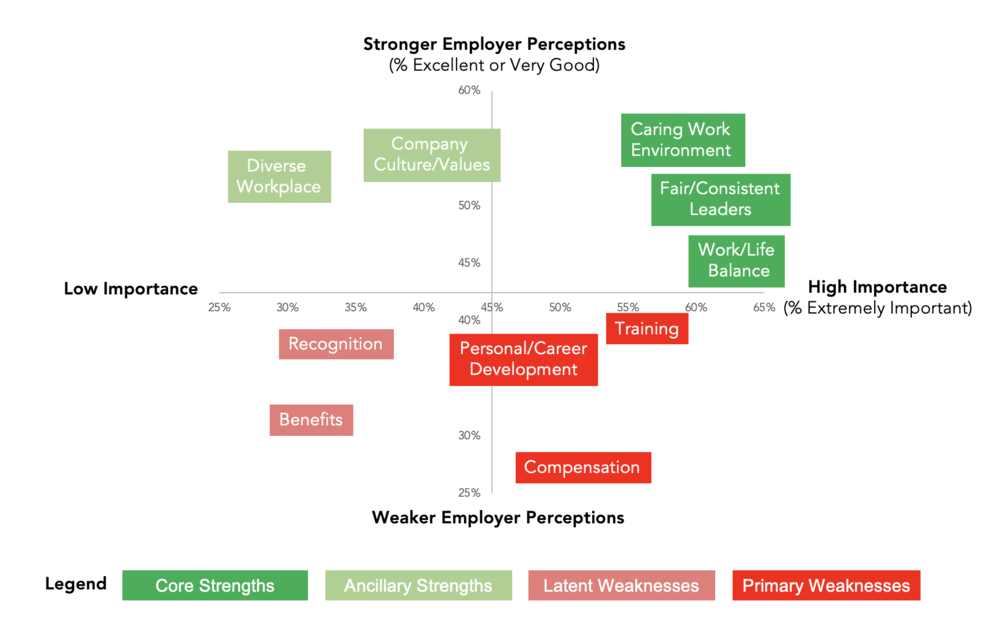
Our Key Learnings From Year One As A Bootstrapped Company
Last week we hit the twelve month mark at Change State. We’d be lying if we told you the
Change State is now part of Recruitics! Learn more
For organizations serious about investing in their employer brands, defining your “value prop” – a.k.a. EVP or EBVP – is an important first step, yet it’s not always easy to know where to begin. Definitions and approaches vary, but at its core, a good EVP should concisely answer this fundamental question: Why should people want to work for you?
Sounds simple enough, but in practice, things can get complicated very quickly. To help simplify the process, we often start by surveying current employees to generate the necessary data to populate an “Employer Brand Perceptual Map” – essentially a 2 x 2 grid with employer brand decision drivers plotted against two dimensions:
Importance: How important is each attribute when considering a potential employer?
Your Employer Brand’s Perception: How is your employer brand perceived on these same attributes?

Similar to a SWOT analysis, an Employer Brand Perceptual Map makes it easy to categorize key dimensions of the employee experience into one of four buckets:
Core Strengths (a.k.a. the sweet spot): Things you’re good at that are also important to employees.
Ancillary Strengths: Things you’re good at that matter less to employees. It’s not necessarily going to hurt anything to mention these, but don’t expect them to carry significant weight when attracting talent.
Primary Weaknesses: These are things you’re less good at that are very important to employees. In most cases these are ideas you won’t lean into too strongly unless you are purposely (e.g., authentically) not good at them. For example, a tech company that expects long work weeks and eschews PTO might actually brag about their lack of work/life balance as an authentic message to attract the right kind of talent.
Latent Weaknesses: Things you’re not so great at that are also not very important to employees. This is the “no harm, no foul” bucket – not a cause for immediate concern, but certainly something to keep a watchful eye on as your talent market evolves.
Best of all, because it relies only on two questions, it’s relatively easy to collect the required data from employees. Below we outline three steps for generating an Employer Brand Perceptual map and some other things to consider in the process.
Choose Your Dimensions
First things first: decide the dimensions against which you want to measure your employer brand. We typically recommend keeping these as “tangible” as possible – things like comp, benefits, training, work/life balance, opportunities for advancement, etc.
Choose Your Employee Audience
For larger organizations in particular, EVP’s are not one size fits all. Software developers may have very different “why’s” behind their choice to work for you than frontline call center workers. Each distinct audience should have its own EVP and corresponding Employer Brand Perceptual Map. In some cases (like the one above) the groupings are obvious before conducting your survey. In others, the survey data itself reveals which team members should be naturally grouped based on what they consider important.
Run Your Survey and Plot the Results
For the purposes of defining your EVP, less is more: We think two primary questions, along with relevant profiling questions (e.g., department, role, tenure, etc.) are plenty to create a powerful Employer Brand Perceptual Map. See below for sample questions.
Importance: When deciding whether or not to consider an employer, how important are each of the following considerations? (4-pt Scale: Not important / Somewhat important / Very Important / Extremely important)
Perception: Based on your experience working for (Company Name) how would you rate it in terms of…(5-pt Scale: Poor, Average, Good, Very Good, Excellent)
Case Study: National Fast-Casual Restaurant Chain
Below is the Employer Brand Perceptual Map from a recent study we did for a national restaurant chain.

On the horizontal axis, we’ve plotted importance and on the vertical axis we’ve plotted the employer brand perceptions, with the EVP “sweet spot” contained in the upper right quadrant. The underlying idea here is simple: strong employer brands are based on attributes that you (a) excel at, and (b) are important to employees.
In this case, our client was surprised to learn that Comp & Benefits, which we hypothesized would be very important to this audience of entry level workers, were actually among the least important factors when considering employers. Using this Employer Brand Perceptual Map they learned their EVP should be built instead around:
Caring Work Environment
Fair/Consistent Leaders
Work/Life Balance
They were also able to use these data to dispel internal concerns that they were underperforming when it came to diversity and inclusion: “Diverse Workplace” is actually one of their strongest employer brand attributes across all demographic subgroups (data not shown), while simultaneously being one of the least important considerations when choosing an employer (in other words: an Ancillary Strength).
In this way, Employer Brand Perceptual Maps can be an invaluable tool for understanding and prioritizing your messaging and an important first step before you invest in a new career site or related recruitment marketing collateral.
Need help defining or validating your EVP? Contact us today for a free consultation.
Share On:
suggested articles

Last week we hit the twelve month mark at Change State. We’d be lying if we told you the

Discover how consumer and employer brands influence each other, and why investing in both is crucial for sustainable growth.

In our recent blog post, “How Generative AI Is Shaping the Future Workforce”, we explored how AI is transforming
Software Solutions
Copyright © 2025 Charge State. All rights reserved.
Software Solutions
Copyright © 2025 Charge State. All rights reserved.